Making Homemade Sourdough Bread can sound intimidating. Having to make a Starter is the number one reason some folks are hesitant to begin making sourdough bread.
In reality, it can be very simple and easy. If this is your first time, don't sweat it. By using this easy-to-make sourdough starter using potato flakes recipe, you will be a pro in no time.
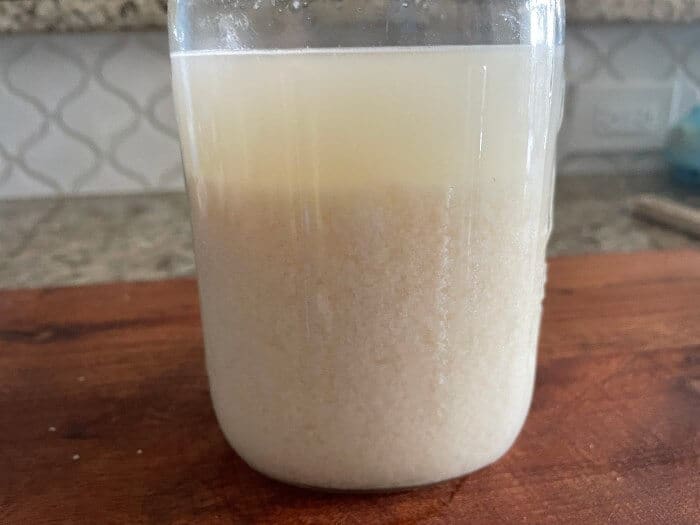
Why Do I Need a Sourdough Starter?
To make bread, you have to have a leavening agent. A leavening agent is simply the substance that causes bread to rise.
This happens when a gas called carbon dioxide is released either through a chemical reaction or when the yeast begins feeding on the sugars. This causes the dough to expand.
In this case, the sourdough starter is our leavening agent that causes our bread to rise.
What is a Sourdough Starter?
A sourdough starter uses wild yeast and bacteria that are grown in what is somewhat of a science project. A sourdough starter is fermented, which causes yeast and bacteria to grow.
We have all heard about how great fermented foods are for your body and gut, and sourdough bread is no different.
By taking water and flour, wild yeast and bacteria are grown in a symbiotic community. This creates a wholesome leavening agent to help the bread rise and in the same sense, flavors the bread the same way that yogurt is by giving it that sour taste.
There are Different Types of Sourdough Starter
There are many different types of sourdough starters that all make great sourdough recipes.
The basic, more traditional way to make a sourdough starter starts with just flour and water.
Some starters are more sour, like a more familiar San Francisco-style starter. Some produce a sweeter, less sour bread similar to the one we are sharing today.
The Flavor and Texture of the Bread Made with A Sourdough Potato Flake Starter
This starter produces a very light and fluffy bread that is slightly sweeter and less sour than traditional sourdough bread.
The results will be similar to traditional white bread but will have all the great benefits of sourdough bread.
This sourdough starter using potato flakes will be used to make our Easy To Make Sourdough Bread Using a Potato Flake Starter Bread Recipe and you can also make these wonderful Sourdough Cinnamon Rolls from this starter as well.
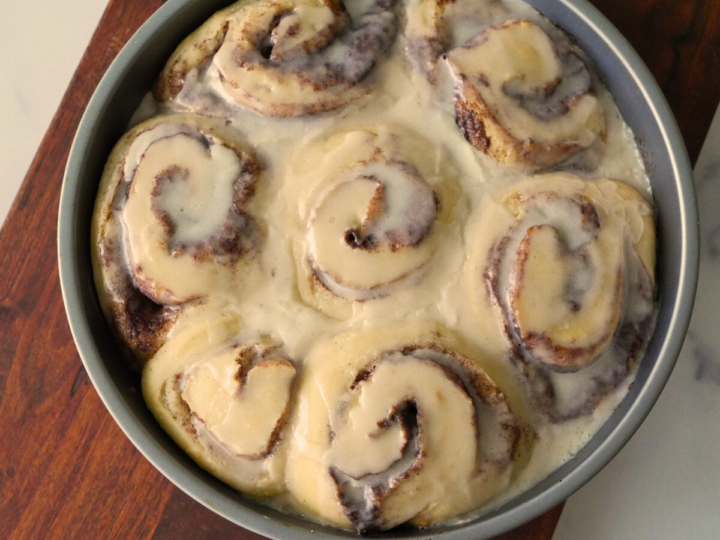
In the steps below, this article will teach you how to create a robust sourdough starter infused with the rich flavor of potato flakes using yeast. This simple recipe combines the tangy essence of sourdough with the added depth of potato, resulting in a versatile starter that's perfect for a variety of breads and baked goods.
How to Make Potato Flake Starter for Bread
What You Need to Make This Recipe-Starter Ingredients
Instant Mash Potato Flakes
To make a fermented sourdough starter, you have to have something to ferment. In this case, we are using potato flakes to grow our yeast and bacteria. Any brand will do. I often use the Idahoan Potato Flake brand. You will need 3 tablespoons of potato flakes.
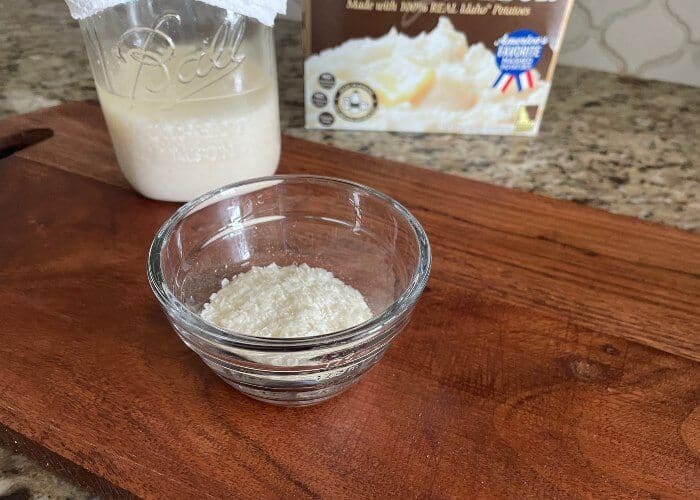
White Sugar
White sugar is what feeds the yeast and bacteria. It is yeast's primary food. You will need 3 tablespoons of sugar.
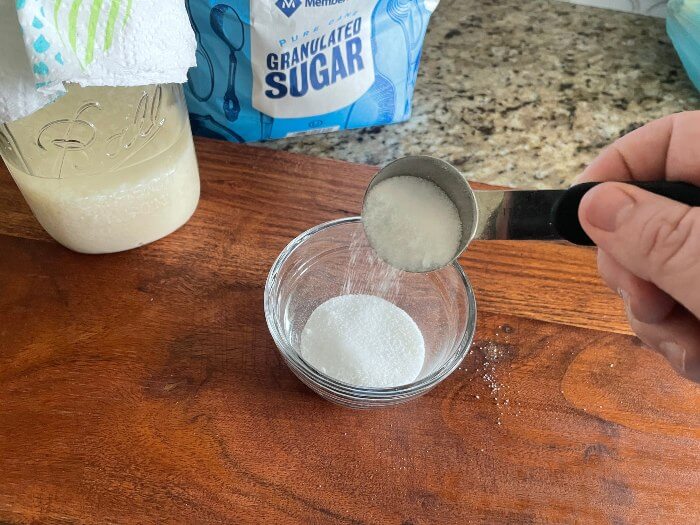
Active Dry Yeast
In this recipe, we jump-start the yeast with a Commercial yeast packet that you can buy from the grocery store. We like to use active dry yeast.
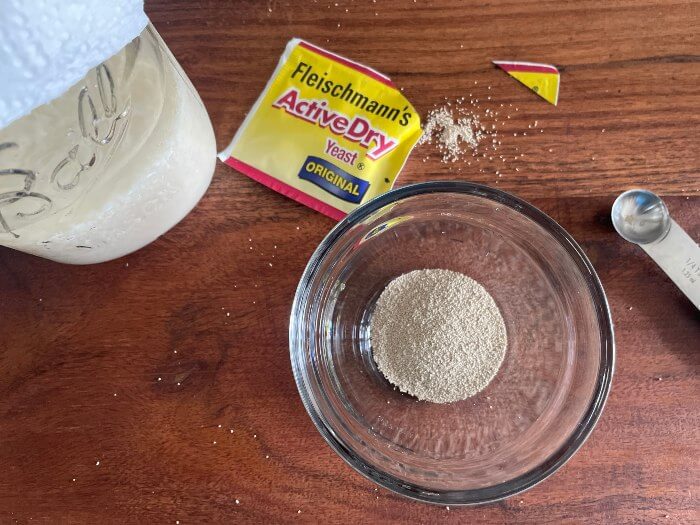
This recipe starts with the commercial yeast but after it gets going for a while the wild yeast will take over. You will need 2 ¼ teaspoons of yeast.
Warm Water
You will need 1 cup of water that is lukewarm. This should have a temperature range of 95 to 115 degrees Fahrenheit. I like to use my instant-read thermometer to check the temperature.
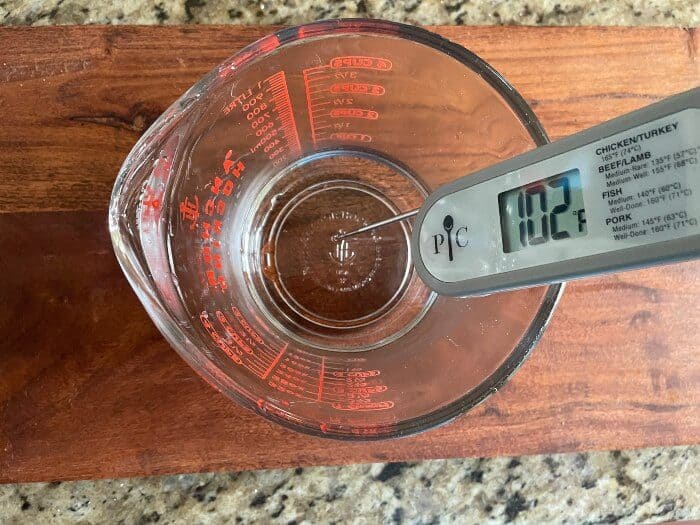
How To Make Sourdough Starter Using Potato Flakes
Follow these steps to cultivate your sourdough starter with yeast and potato flakes, and elevate your baking game with a unique twist.
Step-by-step instructions
Step 1: Start with a clean glass container or a large bowl. I like to use a mason jar.
Step 2: Add in the warm water, then add in your dry ingredients.
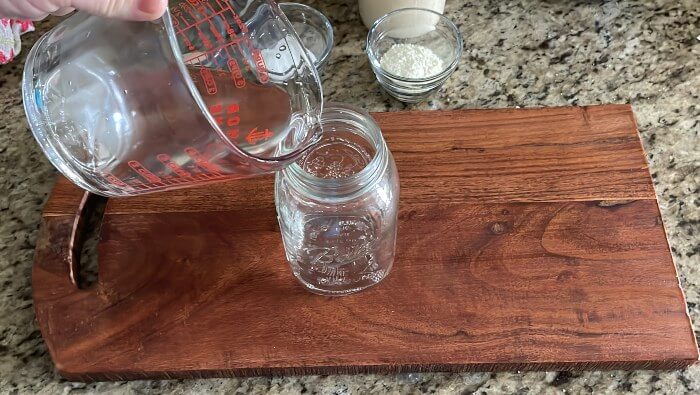
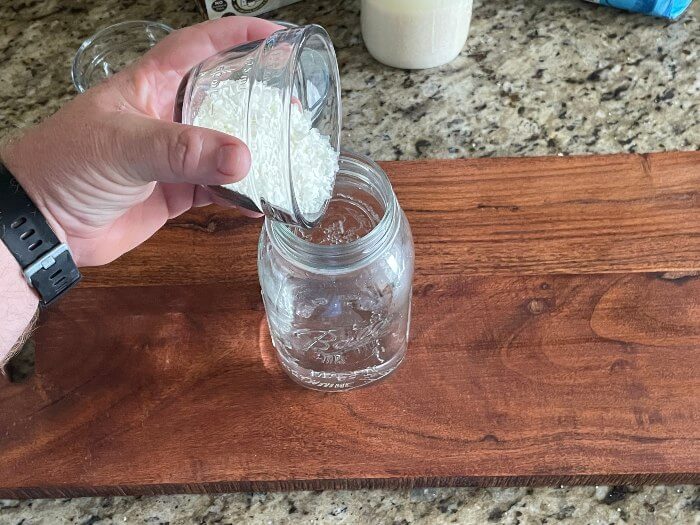
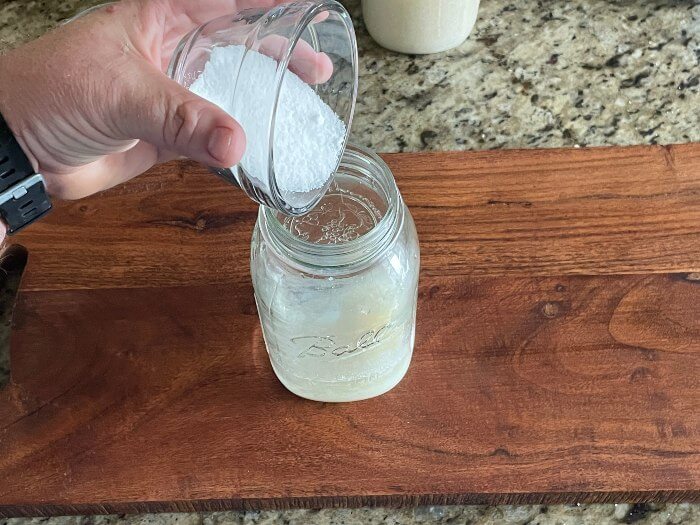
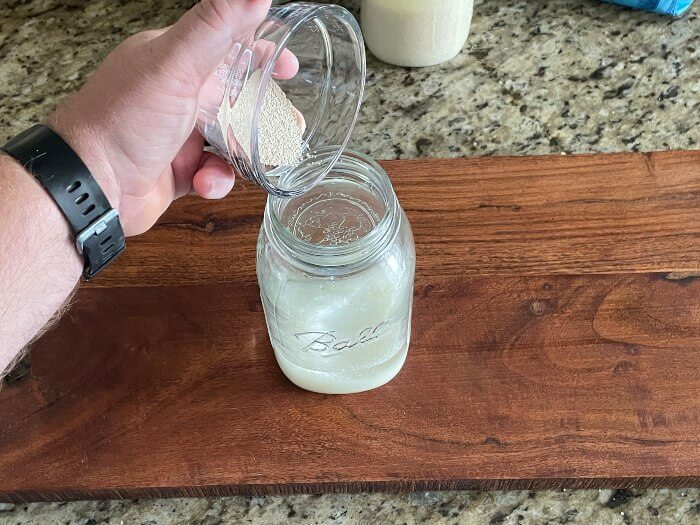
Step 3: Stir with a wooden spoon. Do not use metal because it can react with the ingredients. I am using the handle to stir because the mouth of the jar isn't wide enough for the spoon to fit in. You could also use a hard plastic straw.
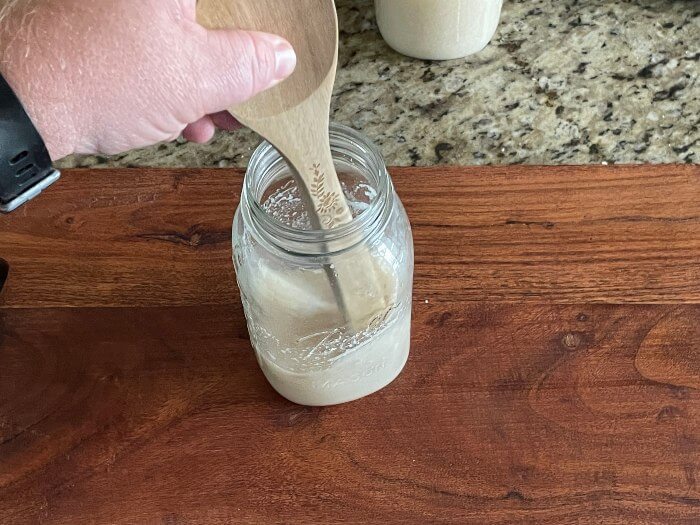
Step 4: Cover the dish with a clean dishcloth or cheesecloth, something where it can breathe. Do not refrigerate this mixture at this point. Leave it in a warm place for 5 days at room temperature so the yeast and bacteria can go on a feeding frenzy.

Step 5: Stir the starter every day.
Step 6: On the morning of the 5th day, you will feed the starter. Add in 3 tablespoons of instant potato flakes, 3 tablespoons of white sugar, and 1 cup of lukewarm water.
Step 7: Stir this and continue to let it sit out at room temperature for at least 6-8 hours.
Step 8: After it has sat out at room temperature for 6 to 8 hours, remove 1 cup of the starter to make your bread. Make sure to stir the starter well before you remove the 1 cup of starter. You will then place the rest of the starter in the refrigerator.
Pro Tip: On the 5th day, you are ready to use the starter to make your bread so be prepared for this last step. You will use this to make bread every 5 days. You can make bread every day if you feed it each morning and then remove the 1 cup of starter at the end of the day to make the bread.
Feeding The Potato Flake Starter
Feed the starter every 3 to 5 days-Keep it refrigerated until the day you feed it.
Step 1: Add in 3 tablespoons of instant potato flakes, 3 tablespoons of white sugar, and 1 cup of lukewarm water.
Step 2: Stir this and continue to let it sit out at room temperature for at least 6-8 hours.
Step 3: After it has sat out at room temperature for 6 to 8 hours, remove 1 cup of the starter to make your bread. Make sure to stir the starter well before you remove the 1 cup of starter. You will then place the rest of the starter in the refrigerator.
If you are not going to make bread at least every 5 days, you can still feed the starter and then discard the 1 cup. There are also recipes that you can use the discard for as well.
Other Ways To Use the Discard Potato Flake Starter
- Discard Pancakes
- Cinnamon Rolls
- Amish Friendship Bread
- Sourdough Yeast Rolls
- Give a Cup to a Friend
Give your friend 1 cup of starter. Then on the 5th day, they will start with steps 6-8. Print the recipe off and give it to them along with the 1 cup of starter.
FAQ’s
Once I make the starter, do I leave it sitting out or refrigerate it?
Once you make the starter, you will leave it sitting out on the counter for 5 days. You will feed the starter on the fifth day and then 6 to 8 hours later after feeding, you will take a cup of starter off to make bread with. The remaining starter in the container will then go in the refrigerator until you are ready to make bread again.
How Much Bread will this Sourdough Starter Using Potato Flakes make?
Once your starter has hit its maturation on the 5th day, you will remove the 1 cup of starter. The 1 cup of starter will make two loaves of bread if you are using normal-size loaf pans.
How Often Do I Have to Feed the Starter?
To keep the sourdough starter active, you will need to feed it every 3 to 5 days using steps 6 through 8.
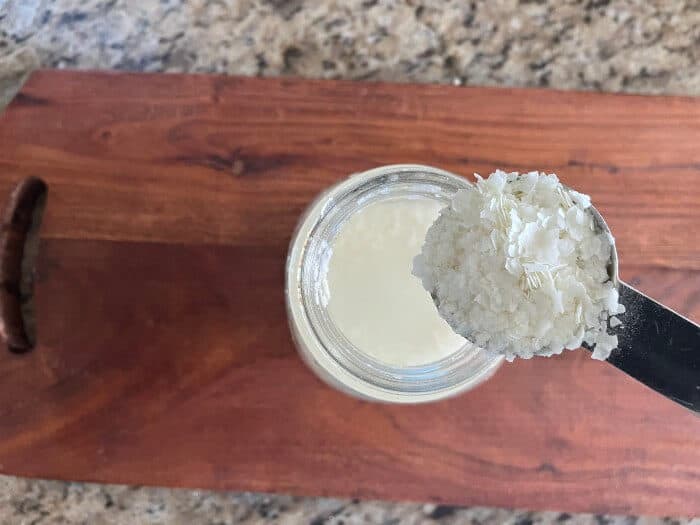
How Long will the Potato starter last?
This starter will last for many years as long as it is taken care of. The current starter I am using is about 2 years old. I have read of people having it for over 30 years.
How Should I Store the Potato Flake Starter?
You can store the starter in a glass jar. Do not use a metal lid. You can use a lid off of an old mayonnaise jar and punch a few holes in it. You could also cover it with plastic wrap, cheesecloth, or even a paper towel.
I use a paper towel over the lid with a rubber band to hold it on. Do not use the metal lid and ring from the mason jar or aluminum foil.
Can I Use This Starter to Make Another Type of Bread?
Yes. You can make Amish Friendship Bread with this as this is very similar to the Amish Friendship Bread Starter recipe.
What if I Forget to Feed it on the 5th day?
Feeding it on the 5th day is just a recommendation. I have skipped feeding it for a month and it still turned out great. I would not make that a habit but it should still be fine.
What Can I Do With the Discard?
You can make many great recipes with the discard. One popular one is pancakes. Another very awesome one is cinnamon rolls.
Can I Use a Plastic Container?
Yes, you can use a plastic container if you wish.
Does this sourdough starter make sour bread?
No. This starter makes lightly sour bread that has a sweet taste.
My Sourdough starter is Liquidy and not a paste like a traditional sourdough starter.
This is normal. This starter will be watery and will not get thick like your traditional sourdough starter.
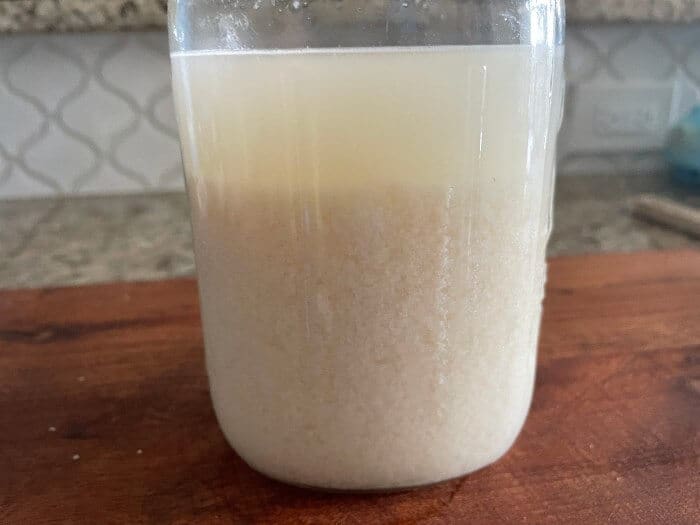
I hope you enjoy this Easy to make Sourdough Starter using Potato Flakes. I am sure you will make lots of homemade sourdough bread with it. If you feed this sourdough starter on a regular basis, you will have a starter that will last a lifetime if you wish.
-Ronnie
Easy to Make Sourdough Starter Using Potato Flakes
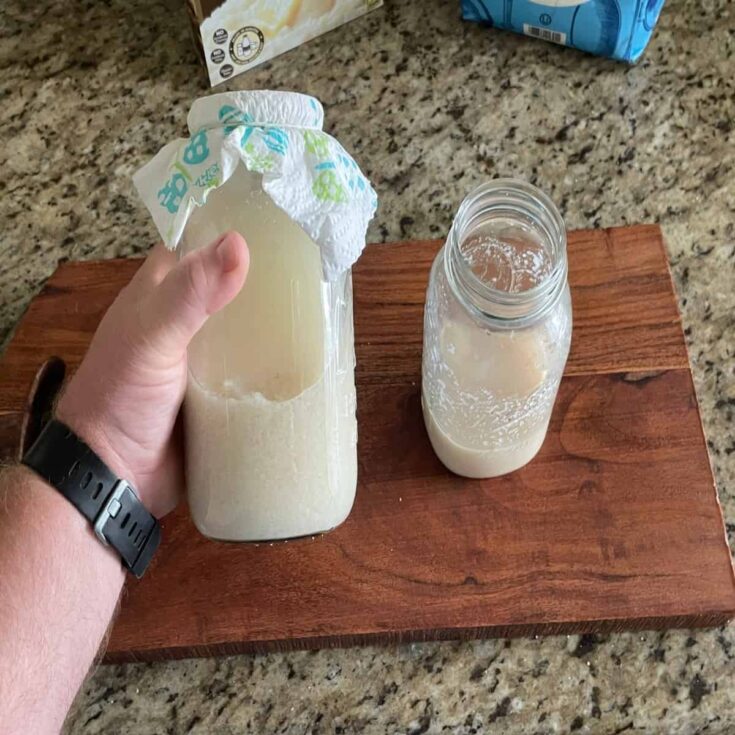
Making Homemade Sourdough Bread can sound intimidating. Having to make a Starter is the number one reason some folks are hesitant to begin making sourdough bread. In reality, it can be very simple and easy. If this is your first time, don't sweat it. By using this easy-to-make sourdough starter using potato flakes, you will be a pro in no time.
Ingredients
- 3 tablespoons Instant Mash Potatoes
- 3 tablespoons white sugar
- 2 ¼ teaspoons active dry yeast
- 1 cup water (lukewarm)
Instructions
- Start with a clean glass container or a large bowl. I like to use a mason jar.
- Add in the warm water, then add in your dry ingredients
- Stir with a wooden spoon. Do not use metal because it can react with the ingredients.
- Cover the dish with a clean dishcloth or cheesecloth, something where it can breathe. Do not refrigerate this mixture at this point. Leave it in a warm place for 5 days at room temperature so the yeast and bacteria can go on a feeding frenzy.
- Stir the starter every day.
- : On the morning of the 5th day, you will feed the starter. Add in 3 tablespoons of instant potato flakes, 3 tablespoons of white sugar, and 1 cup of lukewarm water.
- Stir and let the starter remain for 6 to 8 hours before using it on the 5th day.
- After 6 to 8 hours after the starter has been fed on the 5th day, remove 1 cup of the starter to make your bread. Make sure to stir the starter really well before you remove the 1-cup starter. You will then place the rest of the starter in the refrigerator.
Feeding The Starter
- Add in 3 tablespoons of instant potato flakes, 3 tablespoons of white sugar, and 1 cup of lukewarm water.
- Stir and let it sit out on the counter at room temperature for 6 to 8 hours.
- Stir well then remove 1 cup of the starter to make your bread with. Place the remainder of the starter back in the refrigerator until you are ready to make bread again.
If you are not going to make bread at least every 5 days, you can still feed the starter and then discard the 1 cup of starter. There are also recipes that you can find to use the discard starter for as well.
Notes
On the 5th day, you are ready to use the starter to make your bread so be prepared for this last step. You will use this to make bread every 5 days. You can make bread every day if you feed it each morning and then remove the 1 cup of starter at the end of the day to make the bread.
If you are not going to make bread at least every 5 days, you can still feed the starter and then discard the 1 cup. There are also recipes that you can use the discard for as well.

Nutrition Information:
Serving Size:
1 gramsAmount Per Serving: Unsaturated Fat: 0g
Also, try these delicious recipes as well:
Marinade for Smoked Beef Jerky
Chicken Bog | A Traditional South Carolina Dish
Southern Food Junkie Chili
Brunswick Stew
Home
Recipe adapted from The Southern Lady Cooks Website

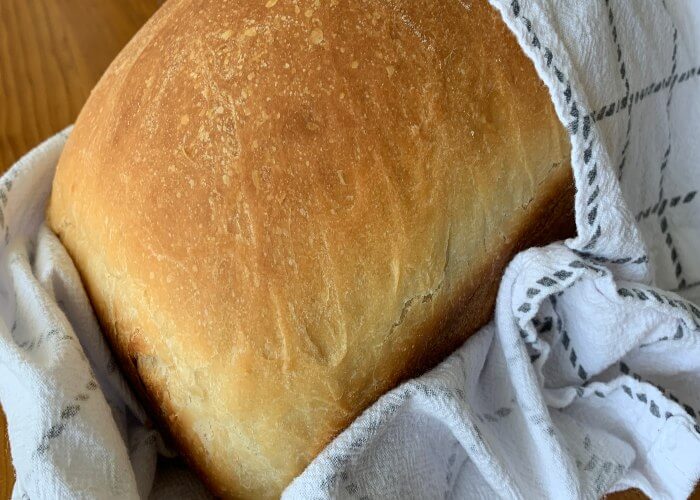

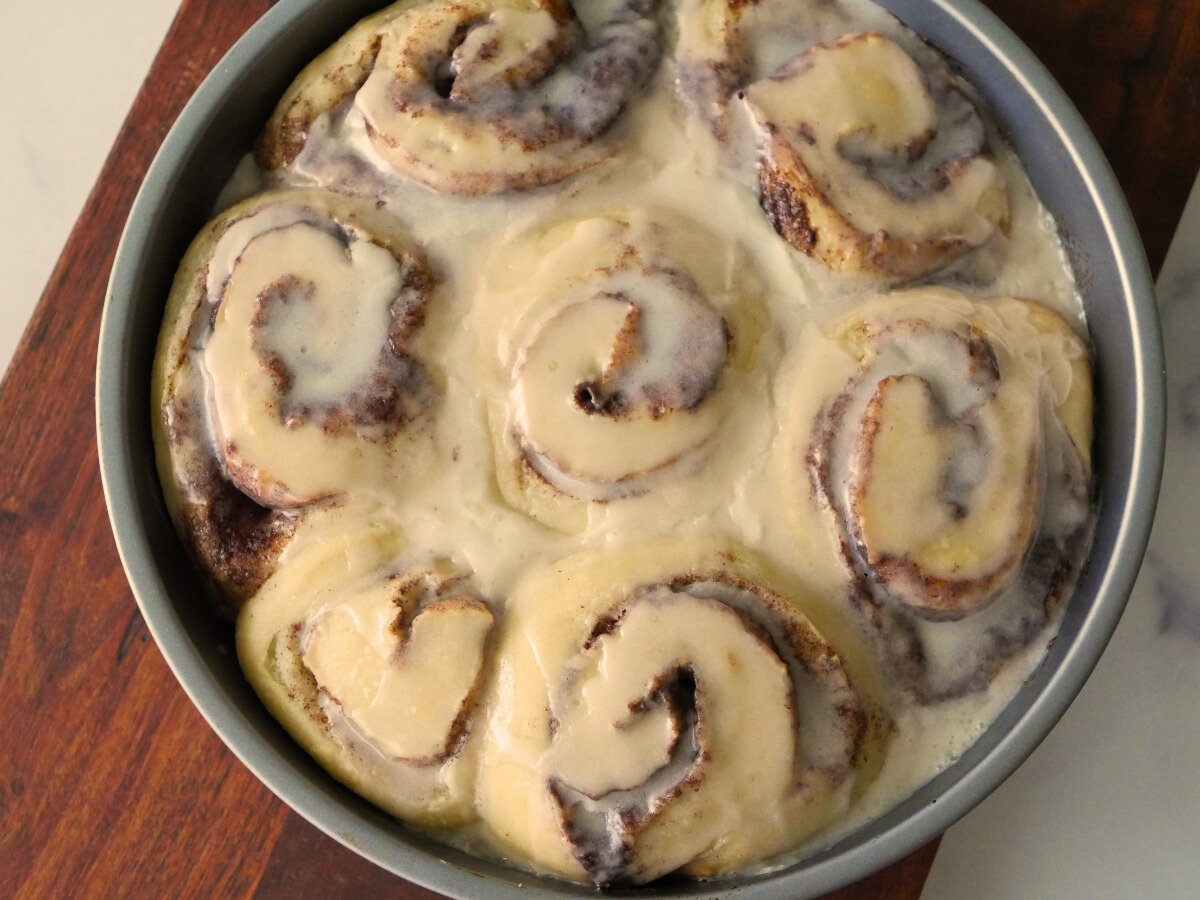

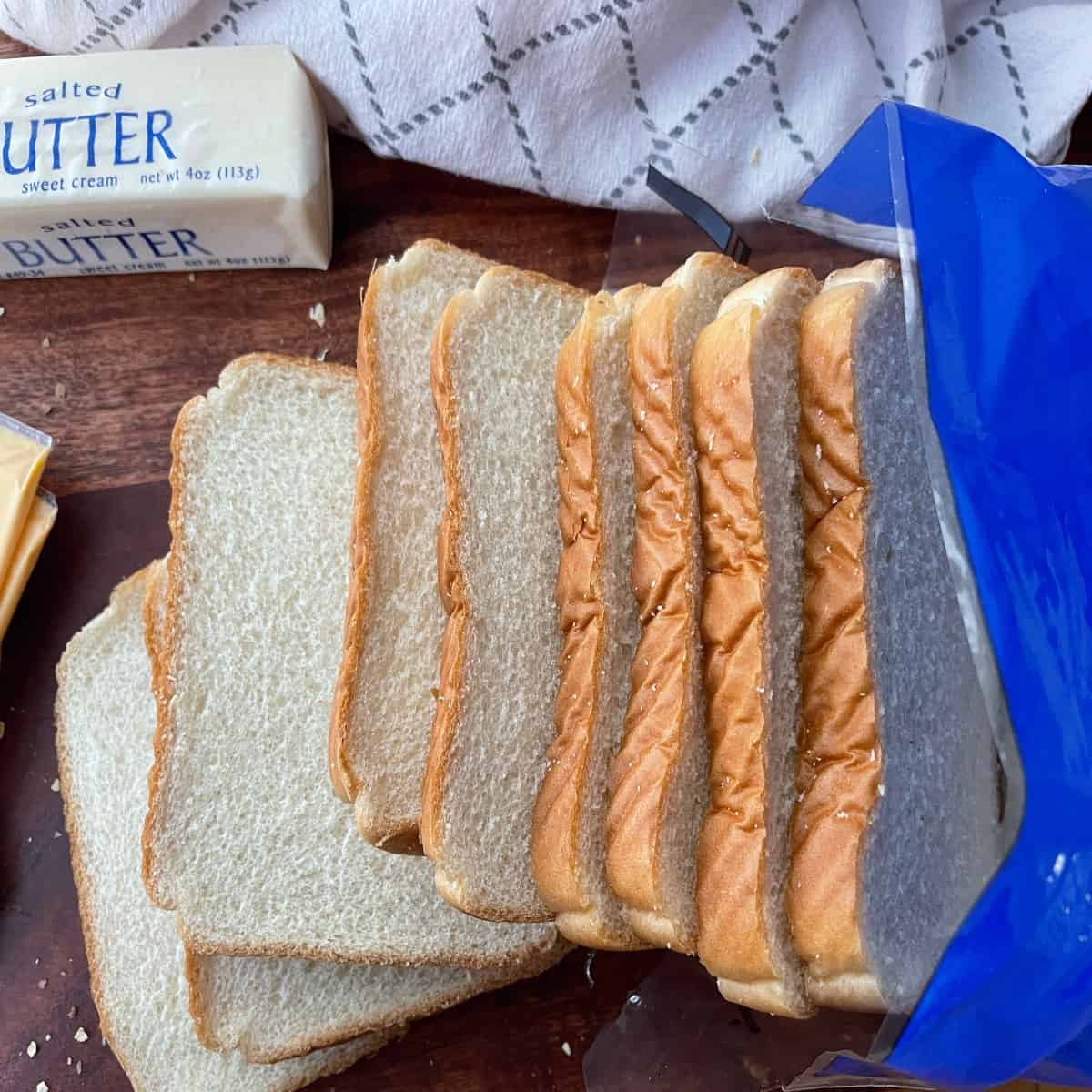
Craig Whitley says
This was an unqualified HOME RUN! On day 7 after I had already given the starter its 1st Feeding, I took 1 cup of the starter out of the fridge to let it warm to room temp. I mixed everything at 11PM expecting a slow rise and expected to divide and proof at 7 or so the next morning. Fortunately, I got up at 4AM and it was about to push the lid off my KitchenAid Mixer bowl. So, bleary eyed, I divided it and put it in 2 loaf pans, and by 7AM I had to start the oven as they rose so fast. A very nice uniform tight crumb yet very soft.
With just 2 people in the house this starter will fit in very well with our limited need for baking. Thanks
Ronnie Williams says
So awesome to hear! I haven't found anyone that I have given a loaf of this bread to that does not like it. It is so good that you can eat it plain. I am happy to hear that it worked out great for you. Thanks for sharing.
Dale says
@Ronnie Williams,
I am on day 4 of my starter, can I feed it early and make bread this evening ?
Ronnie Williams says
Hey Dale,
I would stick to the recipe as far as starting the starter goes. Once it has been established, you can stray off of it to some extent as far as the feeding schedule goes. I sometimes stretch my feeding times out to a month without feeding as long as it stays in the refrigerator, but this is after the starter has been established.
Jeannie says
@Craig Whitley, my dough is on glass or plastic bowls only..it doesn't do good with metal...I use my kitchen aide mixer only to mix together..good luck!!
Patty says
Hi, I just made my first 2 loaves of this bread, and it smells wonderful! My question is, can you freeze the starter? We will be away for an extended period of time, and it would be nice to get home and feed it and use it!
Ronnie Williams says
That is so awesome. I never tried freezing it so I honestly do not know if it would survive. I do know that I have gone extended amounts of time (a month or two)without feeding it, leaving it in the refrigerator and it has still worked. It will be a little less active but once you feed it regularly a few times it should spruce back up. I actually am making some myself today! Thanks for your comment.
Teri says
@Patty, I was told from a friend that makes it all the time that you could freeze it. She does all the time.
Malinda Watkins says
@Patty, what recipe did you use to make the bread?
Ronnie Williams says
Here you go Malinda: https://southernfoodjunkie.com/easy-to-make-sourdough-bread-using-a-potato-flake-starter/
Corrie says
I’ve had my starter in the fridge for 2 weeks , is it still good ?
Ronnie Williams says
Yes, it should still be fine. I sometimes go 30 days without feeding. It is not recommended to do that as it can make it weak, but if you just forgot to feed it, it should still be fine.
Robin says
Would this be considered gluten free?
Ronnie Williams says
No, this would not be gluten free as it still uses flour made from Wheat.
thanks
Nicole says
My bread is not rising as good as the first few rounds. Can I add more active yeast to my starter or to my bread when I’m making bread?
Ronnie Williams says
Hey Nicole,
I wouldn't add more to it. Mine sometimes does that too. The more often you use it and feed it on a regular schedule, the stronger it will get. I also notice it not rising as much in the wintertime as my house is cooler than in the summertime. We keep our heat on 68 in the winter and in the summer, the AC stays on 75. I am not sure where you are trying to rise it, but putting it in the oven with the oven light on helps this. It likes to be in a place that is a constant temperature and is warmer. I usually just roll with mine, after the second rise mine usually catches up. The last time I put mine in the oven, the dough was in a plastic bowl. My wife came along and turned the oven on to preheat it without checking to see if anything was in the oven. Well, this was a big disaster haha. Melted plastic and toxic fumes in the house. We had to open all windows and go ouside for a while to let it air out.
Thanks Ronnie
jerri says
Help! I made sourdough with potato flake starter for years. In moving my schedule changed and my starter which was stored in the frig seems dead. Can I refresh it in some way? Feeding it does not work. Did that 3 times. Don't want to start over. Help?
Ronnie Williams says
Hey Jerri,
I have had mine stored in the frig for over a month before and it was still active. If feeding it again doesn't reactivate it, I am afraid you will have to start over with a new one. There may be a way to revive it but I have never tried it so I don't want to advise you wrong. I hope that helps.
Thanks in advance,
Ronnie
Betty says
I just tried my first run of bread with the starter. I put it in the oven with the light on before bed this mourning it has not raised at all. I followed your instructions step by step but it didnt see to work. I used this starter years ago but was given the starter by a friend. I cant seem to get the starter going. What am I doing wrong.
Ronnie Williams says
I hate to hear that Betty. So this was a brand new starter you made following my instructions? Did the starter have a fermented smell before you made it? It is possible you might have had some old yeast. Otherwise, I am not sure what might have gone wrong. I have never had an issue with my starter working following these instructions.
Judy says
Do you leave the starter out for the first 5 days? When you first make it?
Ronnie Williams says
Hey Judy,
Yes, you will leave the starter sitting out on the counter for 5 days. After that, you take off your first cup of starter to make your bread, then you refrigerate the starter until you are ready to make bread again. Then when you want to make bread again, you get your starter out of the refrigerator and feed it. Let it sit out on the counter for 8 hours before you take your cup of starter out to make bread. Then take your cup out, and back in the refrigerator. If you are making bread every day with it, I think you can just leave the starter out. I have never done that before though. I hope this helps to clear up any confusion.
Thanks again for stopping by,
Ronnie
Mary Smith says
@Ronnie Williams, I have some that said sit out 2 days, you say 5? I just did mine this morning 5/3 at 10am. Same recipe but different stay out days
LeighAnne Wilson says
I'm a little confused....when first starting out, do you let this sit out on the counter for 5 days, stirring each day, or just 24 hours and then refrigerate?
Ronnie Williams says
Hey LeighAnne,
Sorry for the confusion. I will go back and look at that part to see if I can make it flow better. To answer your question, yes when you first make the starter, it will sit out on the counter for 5 days. At that point you can take a cup of starter to make bread, then refrigerate the rest of the starter until you are ready to make bread again. When you are ready to make bread again, you will take the starter out, feed it, let it sit for 8 hours, then take a cup of starter out to make the bread. Then you put it back in the refrigerator. Thanks for stopping by and I hope this answers your question.
Thanks again,
Ronnie
Wendy says
I’ve used this type starter for a few months and love the bread. To feed the starter I use calls for 3 T potato flakes, 3/4 c sugar, 1 c warm water. I fed it 3 days ago and mistakenly added 1 c sugar. Did I ruin it?
Ronnie Williams says
Hey Wendy,
I have never done that so I honestly can't say but if it were me, I would just try to use it and see what happens.
Thanks for the comment.
Ronnie
Karen says
You have to use Bread Flour.
Ronnie Williams says
Hey Karen,
While you most certainly can use bread flour, this recipe doesn't call for it. Bread flour will give a different texture. Instead of being softer and fluffier, it will be chewier. While I do use bread flour sometimes, I always use AP flour for this recipe.
Thanks for your comment though,
Ronnie
Malinda Watkins says
@Ronnie Williams, I have started my starter, now I need a good recipe that to make the bread.
Ronnie Williams says
Malinda,
That is awesome. I have the recipe for the bread tagged in this blog post but also, here it is for you. Just click on this link:
https://southernfoodjunkie.com/easy-to-make-sourdough-bread-using-a-potato-flake-starter/
Kelly Ebel says
I made this bread the other day and it is amazing! So I put my starter in the fridge and will need to feed every 3-5 days. Do I need to bring starter to room temp before feeding it or can I feed it right away then let it set out before making my bread again? Thanks!
Ronnie Williams says
Hey Kelly,
The way I feed mine is I take it out of the refrigerator, feed it, then let it set out for 6-8 hours. I do this whether I am going to use the starter to make bread, or if I am just doing my routine feeding and going to discard the starter. Also, there are many great recipes to use the discard for instead of throwing it away. I hope to publish some at some point and time but you can search for them. You could also give that cup away to a friend and then they will have their own starter. They would then store it in the refrigerator until it is time to feed it. I hope this helps.
Thanks,
Ronnie
Kelly Ebel says
Hello. After the starter has been in the fridge so I need to bring it to room temp before feeding it again?
Ronnie Williams says
Hey Kelly,
You can feed it as soon as you bring it out of the refrigerator. Then let it sit for 6 to 8 hours before using the starter.
Karen says
The recipe I have is very similar to yours. I’ve made perfect bread until today. My dough was very wet and didn’t rise in the bowl after mixing nor in the pans. Not sure what happened. Did everything the same. I was thinking of adding some more yeast next time I feed. Yes or no? Also on another site , I read that after feeding and taking the 1 cup to make the bread, you only put 1 cup back in refrigerator for your starter and discard the left over. I didn’t see this in your instructions, so do you keep everything or just the 1 cup?
Ronnie Williams says
Hey Karen,
The discard you are referring to is only if you do not make bread. Essentially you will only have 2 cups of starter in your jar after feeding it. You had one cup to start with when you made it, then when you fed it, you added a cup of water. So this gives you a total of two cups. After you have fed your starter, you take out one cup to make bread with or discard that cup if you are not making bread. This gives you the option to not make bread if you don't want to but you still need to feed the starter regularly. The remaining cup of starter that is left goes back into the refrigerator until it is time to feed it again.
Sorry, it didn't turn out right. There are many variables that could make this happen such as elevation changes, humidity in the air or your house, etc. If my dough is very wet, I add a little flour at a time until I get the right consistency. Also, make sure when you are scooping your flour out you are packing your cup and use the back of a knife to scrape it off level. This is to make sure you get the right amount of flour each time. I wouldn't add more yeast. Does your starter have a sour smell to it? It should smell fermented after it has set out for 6 to 8 hours after you fed it.
I hope these tips help.
Thanks,
-Ronnie
Deb says
Where can I find recipes that use my sourdough potato flake starter?
Ronnie Williams says
Hey Deb,
I have not posted any yet but I do plan on it. If you do a quick search on google for "Sourdough Discard Recipes" you should get some returns. Just note that this sourdough starter is slightly different than traditional sourdough as it is a little sweeter, not as tangy, and more liquid. One that I am going to be doing soon is sourdough discard pancakes. I am about to upload a traditional pancake recipe this week and hopefully can do the discard one after that.
Thanks for your interest.
-Ronnie
Ronnie Williams says
Hey Deb,
I just wanted to let you know that I posted a Sourdough Cinnamon Roll Recipe that you can use this starter with.
Thanks,
Ronnie
Kathy says
@Ronnie Williams, Can you also post the discard pancake recipe too please?
Thanks so much!
Ronnie Williams says
You are welcome!
Shelly says
I made bread today, my first rise was wonderful. It doubled in size. I punched it down and placed it in my loaf pans for a second rise. But the dough did not rise the second time. Any reasons this might of happened?
Ronnie Williams says
Hey Shelly,
That is very odd. I can say that I have never had that happen before. Usually, if it rises the first time, It always rises the second time. Was it in a cool place during the second rise? How long did you let it rise? Normally the second rise happens a bit quicker than the first for me but just trying to think what would cause that. Sorry, that happened. I would say to keep trying and not give up.
Thanks in advance,
Ronnie.
Diane says
Does anyone from in Illinois have any starter they would share?
Mary Smith says
2 days or 5 days. Recipe I used was exactly the same but days to ferment differ?????
Ronnie Williams says
When making the starter for the first time, it sits out for 5 days. When feeding and making the bread, you leave it out for 6 to 8 hours before removing the cup of starter to make bread with.
Molly says
Have you ever made Friendship bread with this starter? I have looked everywhere for a recipe and I can’t find one.
Ronnie Williams says
I have never made friendship bread with this particular starter. I used to have a starter to make friendship bread with but it was thicker. I do think some people make friendship bread with this starter though.
Jessica says
Help!
This is my first time making this starter.
I mixed all the ingredients together and then realized I had rapid rise/fast acting yeast.
Should I toss this and just start over?
Ronnie Williams says
Hey Jessica,
Sorry for the late reply. I would go ahead and try to use it. I think it will still be fine.
Thanks,
Ronnie
jeannine McElroy says
I love your step by step instructions and pictures. I’ve been making this recipe for years but didn’t have the recipe for the starter itself. I’m sharing this with my family as they love this bread.
Ronnie Williams says
Hey Jeannine,
I really appreciate the comment and also your sharing. That really helps us.
Thanks,
Ronnie
Sherry says
Can I use this starter in my bread machine?
Ronnie Williams says
Hey Sherry,
I have never done this before but I don't see why not. It seems it would be no different than a normal Yeast bread recipe in the bread machine. You might have to split this recipe in half though. This recipe makes two loafs of bread. It uses 6 cups of flour where as my bread machine only used 3 cups. So if you divide this recipe in half, it seems like it would work. But again, I have not done this before so that is just my opinion. If you try it, come back and let us know.
Thanks,
Ronnie
Carol Thornton says
I have been using a potato flakes sourdough starter for over 30 years that I was given. Your recipe seems to be the best for those interested to make a recipe of starter. The only difference I noticed in my feeding recipe is that it calls for 3/4 cup of sugar, along with the 3 Tablespoons of potato flakes and 1 cup of warm water every 3 to 5 days. Now I am wondering I the feeding recipe was possibly written incorrectly over 30 years ago. My recipe is great but now I will try reducing the sugar in one of my extra starters and taste test😁. Thank you for sharing.
Ronnie Williams says
Hey Carol,
Wow thanks for the great comment. 3/4 of a cup of sugar is a lot of sugar. I am interested in knowing how the taste test goes once you make it. Please come back and update us!
Thanks,
Ronnie
Wanda says
I've made this type bread for over 10 years with the same starter. I moved and am now using a starter from someone else's starter. Of course, during the winter I expected poor results but I am not getting good results in the summer. I tried feeding it back to back to built it up but it doesn't seem to be the same consistency as before. It bubbles but not like before. It almost seems not liquidy enough. It never has that great yeast aroma I am used to. The last batch I added 1/2 teaspoon commercial yeast to the flour while still using the starter in the recipe. It turned out great but lost that unique yeast flavor from the starter. Any suggestions?
Ronnie Williams says
Hey Wanda,
I am sorry to hear that your starter isn't working anymore. The only thing I can think of and maybe the best thing would be to just start over and make a new one. I am not sure what would have caused this to happen but if you start over you know you will have one that will work going forward.
Thanks for you comment.
-Ronnie
Michelle Tant says
I have been making this bread for a couple weeks, Is there any way I can add cheese and jalapenos to the bread??
Ronnie Williams says
Yes! My made it like that when I was a kid and it is so good. Fold it in when after the first rise while you are kneading it.
Jeannie says
I'm on day 5 of the potato flakes starter..I had this recipe 13 years ago..realized that I had a Mason jar metal lid with holes on my jar@!!! A NO NO. NOW I AM CAREFUL!!! the starter smells amazing. I also make cinnamon bread and herb bread...it's delish..tytyty!!!
Ronnie Williams says
Good morning Jeannie,
What I found that works really great for a lid is a white coffee filter. One of my readers gave me that tip to use it. It is very durable and last a good while and also breathable. You are right, this starter makes awesome bread and Cinnamon rolls.
Thanks,
-Ronnie
Cathy says
If potato flakes with “butter and cream” added were used to feed the starter, is it ruined or still safe to use?
Ronnie Williams says
Hey Cathy,
I am not 100% sure on that. If it were me, I might would go ahead and try it and just feed it with regular potato flakes the next time. I mean I don't think it will ruin it but it will change the flavor slightly.
Let me know how it turns out. Thanks in advance,
Ronnie
Djones says
How do you make amish friendship bread with this starter?
Ronnie Williams says
Hey,
I have not made Amish Friendship bread with this starter before but it is something that I am going to experiment with in the near future.
Thanks for your interest,
-Ronnie
Helen says
Do you have to wait a full five days with the initial starter? Trying to use for Thanksgiving.
Ronnie Williams says
Hey Helen,
I have never tried to do that when making it so I do not have experience with that. I say try it, what is the worst that can happen? Good luck and I hope it turns out great for you.
Linda says
I can't find this answer anywhere. when you put the starter in the refrigerator, do you cover it with a paper towel or do you seal it with a plastic lid?
Ronnie Williams says
yes cover it but with something that can breath. I like to use a coffee filter as they are breathable and very durable.
Kala J says
Hey. I spaced out and fed my starter then put it back in the fridge. I didn't take a cup out to bake or discard. My brain just wasn't working. When I want to bake Friday, what should I do? Just feed it and leave it out like normal or take a cup out first? Thanks for any advice.
Ronnie Williams says
Hey Kala,
I would take a cup of the starter out now and discard that (throw it away). Then if you want to bake on Friday, you need to feed it again today (Thursday), I would say this morning.
That is what I normally do. I feed it and let it sit out 6 to 8 hours then mix up my ingredients that evening and let proof over night for the first rise. Then when you wake up, you can punch it down, divide the dough, and let it proof for the second time. This should put you baking around lunchtime. I hope that makes sense.
Thanks,
Ronnie
Marti says
I live in Virginia, USA. Of course I had to try this recipe during an extremely cold week of our winter.😞After the second day, my starter appeared to give up. No action at all. My kitchen temp is usually in the mid 60’s. Did I kill it? It’s not even 5 days old yet.
Ronnie Williams says
Hey Marti,
No your starter should be fine. This sourdough starter doesn't really bubble much if at all. Stick with it and it should turn out fine. The only thing you may see is the potato flakes float to the top. Also, it will be watery and not thick like traditionally sourdough starter. I hope these tips and encouragement helps.
-Ronnie
Kent says
I've made traditional breads for years and no problems with rise etc. I've made several attempts with potato yeast and followed the directions exactly. The yeast after feeding is very active with bubbles. I use the amount of yeast to make bread but the rise is very slow and only about half the rise of my traditional breads. I've tried in my bread proofing oven, in my warm garage where my traditional bread goes crazy rising. I've even tried adding some additional yeast when making the bread and even that doesn't help. Any ideas on what may be causing the bread not to rise much? TIA
Ronnie Williams says
Hey Kent,
It sounds like you have done what you should. I am not sure why it is not rising for you. I have never had an issue with mine rising following this method myself. How long do you let the starter sit after feeding it? I typically recommend 6 to 8 hours after feeding before taking the cup of starter to make bread. Is that what you do as well?
Thanks,
-Ronnie
Heather says
I fed my starter but accidentally left it out for 12 hours instead of 6-8 before discarding and putting back in the fridge. Is it ok?
Ronnie Williams says
Hey Heather,
If it were me, I would still be ok with it. I think your starter will be fine to use.
Thanks,
Ronnie
Barbara says
Do I need to stir the starter each day that it is in the refrigerator?
Ronnie Williams says
Good morning Barbara,
No you do not have to stir it everyday if it is in the refrigerator.
Thanks,
Ronnie
Terri says
If I give someone my cup of discard for them to use as a starter, how soon can they feed & use it to make bread?
Ronnie Williams says
Hey Terri,
Sorry for not getting back sooner. I have been out with back surgery and hadn't been checking as soon as I normally do. If you give someone a cup of starter, it depends when you fed it last before you divided out the cup. If you did it today and then gave them the cup, I would have the wait until the next day. You can make the bread everyday if you wanted as long as you following the feeding instructions. The 5 day wait period is the max recommended to go. Thanks for your question and I hope this helps.
Thanks in advance,
Ronnie
Jean says
I didn’t realize I shouldn’t use the metal lid of the jar. Guess I overlooked that part. Is my starter still ok to use?
Ronnie Williams says
Yeah you should still be fine. It is just a guideline. It is possible the metal can cause issues, that is why I mention it.
Thanks,
Ronnie
Sherry says
Hi Ronnie, thank you for sharing how to make the starter. I was given some starter and as one person said, I fed mine with 3/4 cup of sugar instead of 3 tablespoons of sugar. It turned out amazing! It reminded me of Hawaiian rolls. I also put my starter in a metal mixing bowl when I was making my bread and it rose well.
I tried making a new starter following your directions. It smelt good but my bread never rose. It did absolutely nothing and it sat out from 5pm until 8 am. Our house is constantly 78 degrees so I am going to try again after feeding my new starter to see if it works this time. Any suggestions as to why it didn’t rise? Thanks
Ronnie Williams says
I think it taste great as well. I have never used that much sugar before but it sounds like it worked for you. I have made mine in a metal mixing bowl before but I have always been told not to so I always recommend not doing that or using metal spoons. I can't say why yours didn't rise but I have made this many times over the years, as did my mom and it always worked fine. Hopefully next time it will work out for you. Since this has less sugar, it is not quite as sweet and makes a great bread for dinner. I love it with homemade chili and then i like to make French toast with the leftover the next morning or after it has gotten a little dry.